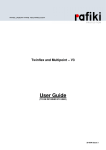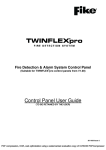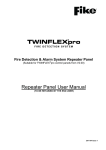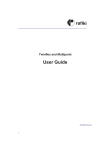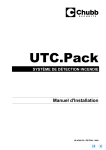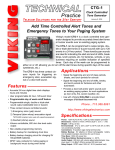Download Manual Call Point Installation and Operating Instructions
Transcript
Manual Call Point Installation and Operating Instructions - Twinflex Installation Surface Mounting Fix the surface back box to a flat vertical surface using at least two of the four mounting holes provided. The back box may be drilled to allow cable access as required and a 20mm hole is already provided at the rear. Zone cabling may be connected to the terminals provided. Flush Mounting The Call Point may be flush mounted utilising the optional ‘adapter-plate’, combined with any standard single gang flush mounting back box (with a minimum internal depth of 25mm). After installing the back box securely, attach the bezel using the two screws provided, and terminate your cables directly into a flying terminal block. Installation 2nd Fix Once all testing has been carried out on the cabling and ‘continuity & integrity’ has been proven, then the Manual Call Point unit may be installed. Call Point Installation The Call Point is installed by locating the upper mounting spigots into the back box and then pushing the unit gently home. The single fixing screw may then be tightened as required. Please remember that all high voltage testing must be carried out before the installation of the Call Point front unit as this may cause damage. Reset and Test The Call Point contains a resettable element, which latches in position when operated and does not need to be replaced. Inserting the key as shown and turning it clockwise until the element clicks back into place will reset the unit. Testing the Call Point may be carried out either by pressing the element or by using the key in the same manner as for resetting but without having pressed the element Technical Support Contact your supplier for technical support on this product. 26-0356 Issue 6 Manual Call Point Installation and Operating Instructions - Twinflex The Manual Call Point is available with or without an integral alarm sounder. If your device has no sounder then ignore all reference to integral sounders on these installation instructions. This device is compatible only with Twinflex control panels and their associated detection and alarm equipment and may be installed on the same zone as the Multipoint detector/sounder, Hatari sounders and input/output modules. The cabling should be 2c1.5 screened and fire resistant, of an MICC or FP200 equivalent type and is to be in the form of a 2-core radial circuit terminating at the End of Line device. The indicating LED will light on operation of the device and switch off on resetting both the device and the control panel. Remember that the ‘End of Line’ device needs its EOL signal activated with its dil switches as below. Do not use a resistor as an End of Line device. NB/ Red = zone +ve, Blue = zone 0V Dil Switch Settings Sound Patterns Single Tone – 970 Hz Dual Tone UK Evacuate – 800 & 970 Hz Slow Whoop Up - 500 to 1200 Hz sweep up Dual Tone French Warble – 440 & 550 hZ High Low Enabled Disabled Sound Levels End of line 1 ON OFF OFF ON - 2 ON ON OFF OFF - Technical Data Dimensions; . . width x height . = 87mm x 87mm , flush depth protruding = 25mm, surface depth . = 53mm. Operating temperature; . . . . = -25’C to 65’C. Voltage Range; . . . . . = 18 to 35v DC Operating Current; . Quiescent . = 105uA (Typical) MCP Alarm . = 25 mA Sounder High . = 16 mA Sounder Low . = 8mA Sound Pressure Outputs; Sounder High . = 85dB(A) Sounder Low . = 72dB(A) LED Operation; . Alarm indication = Continuous EOL indication . = flash at 5 second intervals 26-0356 Issue 6 3 ON OFF - 4 ON OFF


